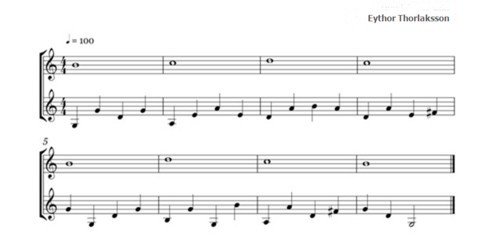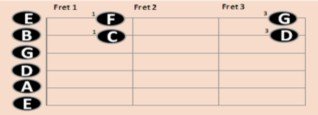Beginner Classical Guitar - Lesson 2: Notes on the B string
All these free beginner classical guitar lessons have the same format. Have a look at how this page is layed out and become familiar with where things are. The heading tells you what the aim of the lesson is and the coloured box contains tips and guidelines. Below the coloured box are your guitar pieces that support the aim of the lesson and supporting resources which include accompaniment in mp3 format and free sheet music in pdf format.These lessons, designed for the beginner classical guitar player, build step by step with each lesson building on the previous lesson in the following ways: (i) knowledge of guitar technique; (ii) familiarity with music reading and (iii) strengthening - and in a safe way - your hands. Try and play through all the exercises provided at the bottom of the page. Remember that the house with the solid foundation is stronger in the long run.
I’m getting a lot of messages from people coming here because they want to learn to play guitar as part of worship. If this is you, you might want to join Aaron Anastasi’s programme. Aaron is a musician and a worship leader. He put together a step by step programme for aspiring Christian musicians. If you're interested, you can use the exercises and advice in learn-classical-guitar-today to develop your finger strength and dexterity and Aaron's lessons to work on strumming and worship music.
CLICK HERE TO LEARN WORSHIP GUITAR !!
Beginner Classical Guitar - Lesson 2 Aims
- Become familiar with and practice using the notes located on the B string.
- Learn the whole note, half note and quarter note.
- Become comfortable with placing the left hand in the correct fret.
- Become comfortable with the i-m-i-m finger alternation on the right hand.
Exercise 5
Exercises 1 to 4 are included in previous lessons

Play along accompaniment
Two mp3s are provided for this lesson. The one contains both parts of the music and the other contains the accompaniment. Listen to both parts of the music played together so that you can get a feel of the song. Then practice by setting your metronome at a very slow pace. Slowly push up the speed until you can play it confidently at a metronome speed of 100. When you can play it confidently at this speed, you can play along to the accompaniment provided.
|
Listen to the song by playing this midi
|
Play along with the accompaniment
|
I’m getting a lot of messages from people coming here because they want to learn to play guitar as part of worship. If this is you, you might want to join Aaron Anastasi’s programme. Aaron is a musician and a worship leader and put together a step by step programme for aspiring Christian musicians. If you are interested, you can use the exercises and advice in learn-classical-guitar-today to develop your finger strength and dexterity and Aaron's lessons to work on strumming and worship music. GO HERE TO LEARN WORSHIP GUITAR
Tips and Guidelines
| |||||||||
Great! Let's keep moving forward
Okay, now you know the drill. The exercises provided below aim at developing the i-m-i-m movement of your right hand and your familiarity with the E string. Play through them by listening to the song and then playing along with the accompaniment. The sheet music can be downloaded by clicking on the pdf.
 Exercise 6 Exercise 6 |
Listen to the song |
Accompaniment |
 Exercise 7 Exercise 7 |
Listen to the song |
Accompaniment |
Well done for getting to here!
Click here for the top three guitars that I recommend for beginners price range of $100 - $200 and intermediate level guitars which is a definite step up.
- You've finished your first seven exercises, are now familiar with and practiced in using the notes of the 1st string and the 2nd string.
- You've practiced alternating between i-m-i-m-i-m with the right handd and are starting to get more comfortable with this.
- Also, you've become familiar and used the whole note, half note and quarter note.
That's great progress.
Let's move on to the lesson three where you'll practice using the notes on the E string and B string in the same exercise. Also, you'll begin using whole notes, half notes and quarter notes in the same piece of music.
Alternately, browse through the lessons below
Lesson 1 - The E String: Start by familiarising yourself with the notes on the E string (1st String) by playing the pieces provided with the MP3 accompaniment. Practice alternating the i-m fingers of the right hand.
Lesson 2 - The B String: Learn and practice the notes on the B string (2nd string) by following the guidelines and playing the pieces with MP3 accompaniment provided. This lesson will help your fingers strength and the i-m right hand alternation will start becoming a little easier too.
Lesson 3 - The E and B String Together: Consolidate your learning of the E and B string by playing through the exercises which provide the opportunity to practice these notes to music arranged with accompaniment in MP3 format. Progress from whole notes, half notes and quarter notes which were used in previous lessons to dotted notes in this lesson.
Lesson 4 - The G String : Learn and practice the notes on the G string (3rd string) by following the guidelines and playing the pieces along with MP3 accompaniment. Enjoy your first introduction to playing music in two voices while allowing the i-m right hand finger combination to become second nature.
Lesson 5 - The D String Together: Become familiar with the D string (4th string) by playing the exercises with the accompaniment provided. Consolidate further working with dotted notes and working with music in two voices. Practice the p-i-m and i-m-p right hand combinations while using the quaver note for the first time.
Lesson 6 - The A String: Become familiar with the A string while you consolidate further your work with two voices and begin, for the first time, working in a new time signature. Practice the p-i-m and i-m-p right hand combinations while using the quaver note for the first time.
Lesson 7 - The E String: Your final lesson. On completion of this lesson you should be ready to prepare for your classical guitar examination Grade 1.

You'll need to go a little deeper into music theory as you proceed. The best online resource for this is Guitar Theory Revolution. It recognises that music theory is very hard for guitarists because music theory has till now been located in the piano paradigm. The Guitar Theory Revolution overthrows the piano paradigm that is holding you back and embraces the attributes of the guitar to unpack music theory. In fact, it goes further and allows you to see that the guitar is one of the best instruments for learning theory.






